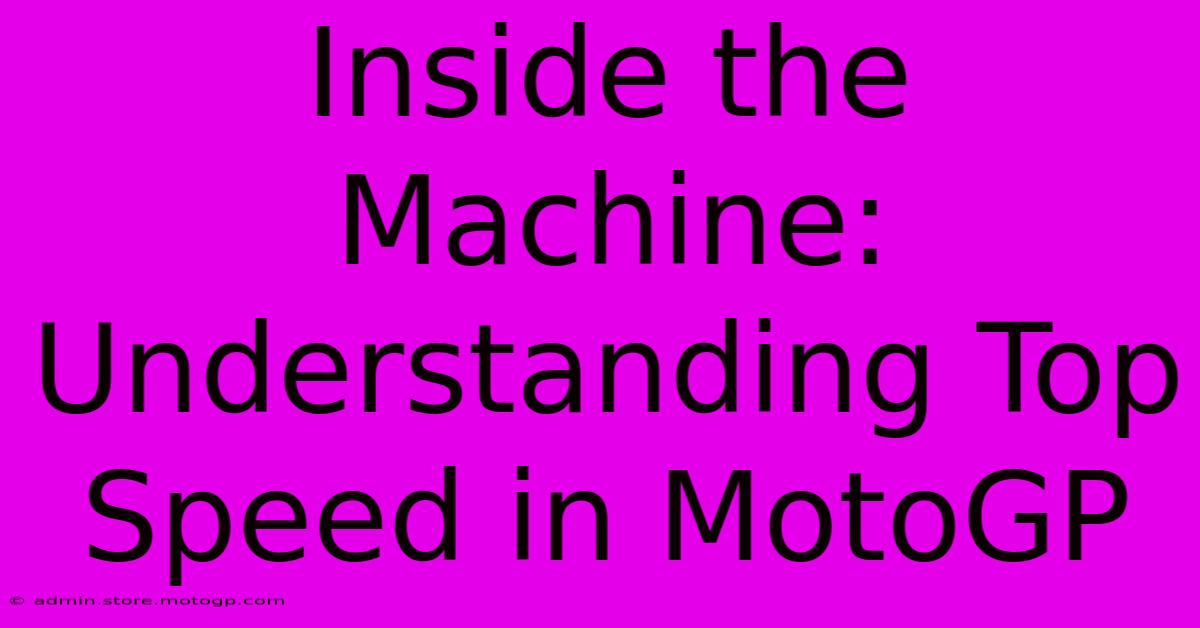Inside The Machine: Understanding Top Speed In MotoGP

Table of Contents
Inside the Machine: Understanding Top Speed in MotoGP
MotoGP. The pinnacle of motorcycle racing. The roar of the engines, the breathtaking lean angles, the nail-biting overtakes… and the sheer, exhilarating speed. But what truly dictates a MotoGP bike's top speed? It's not simply about horsepower; it's a complex interplay of several factors, each contributing to that electrifying final velocity on the straights. This article delves deep into the mechanics, exploring the key elements that determine a MotoGP bike's top speed.
The Powerhouse: Engine Performance
The heart of any MotoGP machine is its engine. These aren't your everyday motorcycles; these are highly-tuned, screaming prototypes pushing the boundaries of engineering. Horsepower is crucial, but it's not the sole determinant of top speed. Torque, the twisting force that propels the bike forward, plays an equally vital role. A high torque engine provides strong acceleration, crucial for exiting corners quickly and building speed. However, achieving ultimate top speed requires a careful balance – maximizing power output across a broad rev range, not just at peak RPM.
Engine Specs that Matter:
- Cylinder Configuration: The arrangement of cylinders (V4, inline-4, etc.) influences engine characteristics, affecting both power delivery and overall efficiency.
- Valvetrain Design: Sophisticated valve systems optimize air intake and exhaust, directly impacting power and responsiveness.
- Fuel Injection System: Precise fuel delivery ensures optimal combustion, maximizing power and minimizing fuel consumption.
Aerodynamics: Cutting Through the Wind
While engine power gets the bike moving, aerodynamics determine how efficiently it overcomes air resistance. At MotoGP speeds, air resistance becomes a significant factor, consuming a substantial portion of the engine's power. Therefore, the design of the fairing, the aerodynamic shell around the bike, is paramount.
Key Aerodynamic Features:
- Fairing Design: Sophisticated designs, often incorporating wings and winglets, minimize drag and generate downforce, enhancing stability at high speeds. The shape and surface texture are meticulously engineered to minimize turbulence.
- Wind Tunnel Testing: Extensive wind tunnel testing is essential for optimizing fairing design and ensuring minimal drag. Every detail, from the rider's position to the smallest component, impacts overall aerodynamic efficiency.
- Rider Position: The rider's tucked-in position minimizes frontal area, reducing wind resistance and contributing to higher top speeds.
Gear Ratios and Final Drive: Finding the Sweet Spot
The gearbox and final drive play a critical role in translating engine power into speed. A carefully chosen gear ratio maximizes the engine's power within the optimal RPM range for each straight. The final drive ratio further influences how engine speed translates into wheel speed. Finding the optimal balance between acceleration and top speed is a delicate art.
Gearbox and Final Drive Considerations:
- Gear Ratio Selection: Matching the gear ratios to the characteristics of each track is crucial. Longer straights necessitate taller gearing for higher top speeds.
- Final Drive Ratio: This ratio determines the relationship between engine speed and wheel speed, influencing acceleration and top speed. Minor adjustments can make a significant difference.
Tire Grip and Traction Control: Maintaining Control at High Speeds
Even with all the power and aerodynamic efficiency, maintaining control at these incredible speeds is paramount. The tires must provide excellent grip, and advanced traction control systems ensure the rear wheel doesn't spin uncontrollably, especially when accelerating out of corners.
Tire Technology and Traction Control:
- Tire Compounds: Specialized tire compounds with high grip and wear resistance are essential for maintaining stability and preventing slip at high speeds.
- Traction Control: Sophisticated traction control systems constantly monitor wheel spin and adjust engine power to maintain optimal traction.
The Rider Factor: Human Element in Top Speed
While the machine is crucial, the rider's skill and technique are integral to achieving maximum top speed. A skilled rider knows how to maximize acceleration out of corners, maintain optimal body position for aerodynamic efficiency, and manage the bike's power and stability at high speeds.
In Conclusion:
Achieving top speed in MotoGP is a symphony of engineering, aerodynamics, and rider skill. It's a testament to the relentless pursuit of performance and a captivating display of technological innovation at the highest level of motorcycle racing. Understanding these intricate elements reveals the true complexity and sophistication behind those breathtaking speeds.

Thank you for visiting our website wich cover about Inside The Machine: Understanding Top Speed In MotoGP. We hope the information provided has been useful to you. Feel free to contact us if you have any questions or need further assistance. See you next time and dont miss to bookmark.
Featured Posts
-
Yamaha V4 Moto Gp The Art Of Speed And Precision
Feb 19, 2025
-
Moto Gp Arcade Game The King Of Arcade Racing Is Here
Feb 19, 2025
-
Cota Austin Navigate The Track With Our Schedule
Feb 19, 2025
-
Moto Gp 23 Ps 5 Become The Ultimate Moto Gp Champion
Feb 19, 2025
-
Moto Gp Sprint Results Who Conquered The Short Track
Feb 19, 2025
